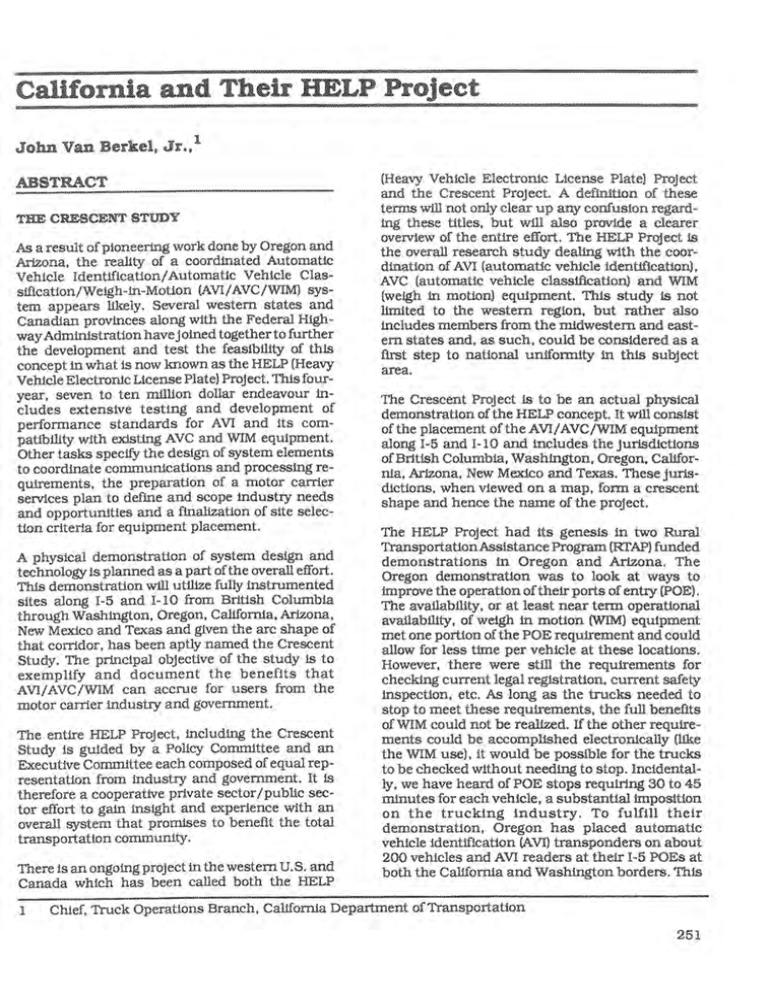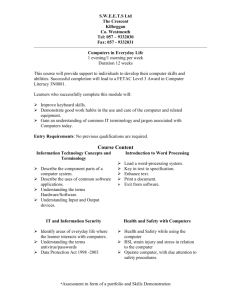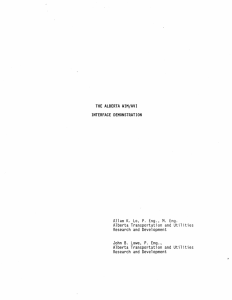California and Their HELP Project = BerkeI, Jr .• John Van
advertisement

= California and Their HELP Project John Van BerkeI, Jr .• ). ABSTRACT THE CRESCENT STUDY As a result of pioneert..ng work done by Oregon and Arizona, the reality of a coordinated Automatic Vehicle Identification/Automatic Vehicle Clas~ sillcation/We1gh~:!n-Motion (AVI/AVC/WIM) system appea.""S likely. Several western states and Canadian provinces along with the Federal Highway Administration have joined together to further the development and test the feasibility of this concept in what is now known as the HELP (Heavy Vehicle Electronic License Plate) Project. This four~ year, seven to ten million dollar endeavour includes extensive testing and development of performance standards for AVI and its compatibility with existing AVC and WIM equipment. Other tasks specify the design of system elements to coordinate communications and processing requirements, the preparation of a motor carrier services plan to define and scope industry needs and opportunities and a finalization of site selection criteria for equipment placement. A physical demonstration of system design and technology 1s planned as a part of the overall effort. This demonstration will utilize fully instrumented sites along 1-5 and 1-10 from British Columbia through Washington. Oregon. California, Arizona, New Mexico and Texas and given the arc shape of that corridor, has been aptly named the Crescent Study. The principal objective of the study is to exemplify and document the benefits that AVI/AVC/WIM can accrue for users from the motor carrier industry and govemmenL The entire HELP Protect. including the Crescent Study is guided by Policy Committee and an Executive Committee each composed of equal representation from industry and government. It is therefore a cooperative private sector/public sector effort to gain insight and experience with an overall system that promises to benefit the total transportation community. a There is an ongoing project in the western U. S. and Canada which has been called both the HELP 1 (Heavy Vehicle ElectrOniC License Plate) Project and the Crescent Project. A definition of these terms will not only clear up any confusion regarding these titles. but will also provide a clearer overview of the entire effort. The HELP Project is the overall research study dealing with the coordination of AV! (automatic vehicle identifkation). AVC (automatic vehicle classillcation) and WIM (weigh in motion) equipment. This study is not limited to the western region, but rather also includes members from the midwestern and eastern states and. as such, could be considered as a first step to national unifomtlty in this subject area. The Crescent Proj eet is to be an actual physical demonstration of the HELP concept. It will consist ofthe placement oftheAVI/AVC/WIM equipment along 1-5 and 1-10 and includes the Jurisdictions ofBrttish Columbia, Washington, Oregon. California, Arizona, New Mexico and Texas. These jurisdIctions. when viewed on a map, form a crescent shape and hence the name of the project. The HELP Project had its genesis in two Rural TransportationAssfstance Program (RTAP) funded demonstrations in Oregon and Arizona. The Oregon demonstration was to look at ways to improve the operation of their ports of entry (POE) The availability. or at least near term operational availability, of weigh in motion (WIM) equipment met one portion of the POE requirement and could allow for less time per vehicle at these locations, However. there were still the requirements for checking current legal registration. current safety inspection, etc. As long as the trucks needed to stop to meet these requirements, the full benefits of WIM could not be realized. If the other requirements could be accomplished electronically (like the WIM use), it would be possible for the trucks to be checked without needing to stop. Incidentally, we have heard of POE stops requiring 30 to 45 minutes for each vehicle, a substantial imposition on the trucking industry, To fulfm their demonstration. Oregon has placed automatic vehicle identification (AVI} transponders on about 200 vehi.cles and AVI readers at their 1-5 POEs at both the California and Washington borders. This 0 Chief, Truck Operations Branch. California Department of Transportation 251 completes the "automation" of POEs for their demonstration. From what we have learned, it appears the demonstration is successful. of the day-to-day details of the study, The study manager reports to the Chairma."l of the Executive Committee. The Arizona study was an attempt to analyze and define the potential benefits to both indusUy and government of implementing a multi-state AVIjAVC/MM system. This study, completed in December 1984, indicated there would be substantial benefits to both industry and government. with possibly the trucking industry receiving the largest portion of the benefits, There are a number of major elements, and hence subco!1nufttees, in the study. TheAVI subcommittee is responsible for reviewing the current stateof-the-art L."'1 AV! eqUipment, developing generic specifications for the AV! eqUipment, fine tUning the equipment t.~rough laboratOIY and field tests and possibly placing a bulk order for AVI eqUipment for use in the Crescent demonstration phase. Based primarily on these two efforts, there was a meeting in Portland, Oregon, in February 1985 of state transportation officials and trucking industry representatives. The result of that meeting was the birth of the multi-state HELP Project. Tue participating agencies include the government and industry from Texas, New Mexico, Arizona, California, Oregon. Washington and British Columbia. Since L"Iose initial meetings, several other states and provinces have expressed a strong interest in the project and have joined the effort. These include Alberta, Nevada, Idaho, Iowa, Minnesota, Pennsylvania and the Federal Highway Administration (FHWA). The HELP Project is being funded by a pooled fund with contributions being made by these agencies. The WIM subcommittee is responsible for developing generic specifications for WIM equipment. Since MM eqUipment is more developed thanAVI eqUipment, a major portion of this effort will focus on the physical placement of the WIM equipment and its relation to MM "accuracy". The study 1s being guided by two committees, a Policy and an Executive Committee. Membership on each committee is available to the transportation offiCials and industry representatives of those states and provinces which have made a fiscal contribution to the study. It is imperative that both government and industry be involved in and committed to this effort as both sectors are needed for a successful study. Both sectors will be impacted by the results of the study and thus are needed Lt'}. this cooperative venture. The purpose of the Policy COmmittee is to provide policy oversight for the study and approve the work program and budget for the study. The ExecutNe Committee functions as the working group giving direction to the study manager. This group is responsible for workplan development. approval ofRFPs and consultant contracts, and recommendations to the Policy Committee. The Executive Committee has further subdivided into subcommittees, each of which is responsible for more detailed review of a major study area. These study areas are described below in more detail. Arizona is providing a study manager and has hired a management consultant to take care 252 The Systems Design subcommittee is responsible for defining the electrOniC interconnect between the AV! and MM eqUipment and the communications and processing requirements for both the public and private sectors. Basically, this task is to define the coordination and flow of the data and w.formation. The Site Selection subcommittee is responsible for developing general guidelines to help the states place the AVI/AVC/WIM stations. This task will probably require a trade off between completeness and t!meliness of data versus capital costs. The Motor Carrier Services subcommittee will be responsible for evaluatir.g the trucking industIy needs and interest in HELP equipment. As part of this charge, the subcommittee will review all HELP products from an industry perspective. The Satellite Reference subcommittee is responsible for investigating and evaluating the current satellite technology and recommending how it could be used in the HELP and Crescent efforts. 1111s work has the potential of either supplementing or replacing the AVI component of the project. There are also two additional efforts ongoing which. although outside of the HELP Project, iI1terface with and could impact the study. One of these is a IS-month project by Iowa and Minnesota to test the feasibility of a low cost piezo-electric WIM in the U.S. and to develop specifications for its production. S:l.milar work is also taking place in Washington State. The development of a low cost AVe/MM could have a significant nnpact on the cost effectiveness of any ultimate HELP system. The second related effort is an NCHRP research project being conducted by Arthur D. Uttle, Inc, This study is to identif:y and evaluate the needs, issues, requirements and feasibility of an AVI/AVC/VlIM system on a national level. This study will also cover some ofthe social issues (e.g., privacy rights) which will not be covered in detail in the HELP Project, Listed below are some of the benefits that have been prelirninartly defined. These include: @ Improved tax auditing III Improved size and weight enforcement @ Automated ports of entry e Automated oversize! overweight permit issuance a..Tld enforcement @ Improved transportation pla..TlIling data e Hazardous materials monitoring monitor and obtaJ.n data [including weight datal at 300 sites over a three year period. The locations for these two requirements are not necessarily the same. Each of these requirements can reasonably be accomplished only by use of electronic eqUipment. We believe it is possible to treat each Crescent station as a master station and correlate other, less precise (and less expensive) VVIM sites to the master station. This would be somewhat analogous to correlating an isolated eight hour vehicle count location to a master count station which makes continuous week long countso Using such a procedure would allow us to meet the above data requirements at a significantly reduced capital cost. If in tUne every commercial vehicle is equipped with an AV! transponder, the data collection would be silnpllfied even more. AVI readers are expected to be su bstantlally cheaper than WIM equipment. Placement of portable AV! equipment could then record an the vehicles and, when "filtered through" the master station, would give the statistical informatlon required at the portable AVI site. As part of the Crescent demonstration, Caltrans has initially selected six sites as master AVI/AVCjWIM locations. These sites were 1& Improved crime detection (stolen vehicle/load) 0& Better fleet management and control e Ill> Reduced paperwork and record keeping at lower cost Fairer competition and lower evasi.on rates These potential benefits (and possibly others) will be verified or rejected during the Crescent demonstration. While benefit areas have been preliminarily defmed in studies. there Is a strong desire to prove they actually exist. The Crescent Project, while somewhat limited in geographic scope, will provide a real life verification or rejection for evexyone to see. As such, the Crescent Project is a necessary follow up to the HELP studies. In California. we view the HELP project as the first step for many of the other activities we are required to perfonn. For example, as part of the StrategiC Highway Research Program (SHRP) , California has been requested to furnish long tenn pavement and axle weight information at over 200 sites. The Federal Traffic Monitoring Guide requires that we selected based upon the locations of neighboring ports of entry (California has no ports of entry), locations of existing long-term pavement monitoring, locations exhibiting maj or changes in five-axle truck travel patterns, and sites having t.ll.e physical pavement charactertstics needed for WIM installation, From a more philosophical perspective, Caltrans views the current efforts in AV! and MM development not as a major new undertaking. but rather we view it as a revolutionary change in electrOniC eqUipment which v?ill allow us, with less personnel, to do a better job of collecting the data needed to make proper decisions in our major activities -. highway design, construction and maintenance. The HELP Project is an expression of that change and, with a little additior~l effort, offers the opportUI1.ity for other groups to also experience benefits for their own use, CalifOrnia believes in the concept expressed above. We feel there are suffiCient potential benefits in the concept that we might have pursued such an effort on our own. However, the additional advantages of coordinating this effort with other states and the trucking industry requires our participation in the cooperative effort, We invite others to join us. 253




